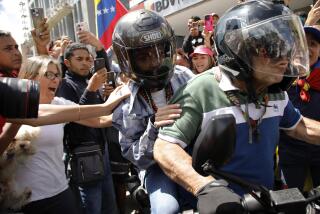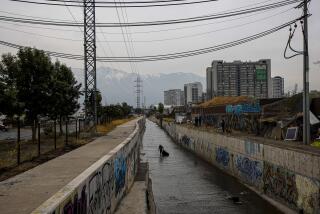Thousands Fast to Protest Economic Austerity in Bolivia
- Share via
LA PAZ, Bolivia — A hunger strike against government austerity policies has spread through Bolivia in recent days as thousands have joined the protest fast, part of a restive climate that Pope John Paul II will encounter when he visits here next week.
Although critics have questioned the hunger strikers’ commitment, some accusing them of snacking on the sly, few Bolivians question the truth of their basic complaint: the “social cost” of official economic policy is painfully high.
President Victor Paz Estenssoro, 81, has stopped one of the worst cases of hyper-inflation in world history, but the cost of the cure has included soaring unemployment, minuscule wages and sharp cutbacks in government services.
This cost has triggered an epidemic of labor strikes and anti-government protest marches in Bolivia, South America’s poorest country. At the end of April, protests in the impoverished mining town of Potosi turned violent, and more than 100 people were injured.
An estimated 6,000 labor, student and political activists have joined the hunger strike since it began April 25. Although protest fasts are not new to Bolivia, this one is the most widespread ever.
Demands include across-the-board pay raises, university budget increases and congressional rejection of bills that would decentralize government-funded health and school systems.
The Roman Catholic Church has been trying to promote a dialogue between the government and leaders of the hunger strike. The church is especially interested in preventing the conflict from complicating the Pope’s five-day visit, which starts Monday.
But the strikers have balked at any truce. For them, the papal visit offers an unusual opportunity to draw national and international attention to their protest.
“The opposition is being more rigid, precisely to take advantage of the Pope’s visit and make a bigger scandal,” said Father Jose Gramunt, a Jesuit who operates a Catholic news agency here.
Although the Bolivian Conference of Bishops has pressed for an end to the strike, it has also repeatedly expressed concern over the social impact of the official austerity policy.
“The conference has been seriously concerned because the social cost is very high,” Gramunt said. He added, however, that the social cost of hyper-inflation is even higher.
When Paz Estenssoro took office in August, 1985, inflation was raging at an annualized rate of 60,000%, according to a study by Jeffrey Sachs, a Harvard University economist.
“The Bolivian inflation may be unique in the annals of hyper-inflation as the only case that did not arise in the aftermath of a foreign war, a civil war or a political revolution,” Sachs wrote.
Paz Estenssoro imposed his tough austerity program almost immediately. It included a devaluation of Bolivia’s currency, a freeze on government salaries and severe cuts in other government spending.
The inflation rate plummeted to 66% in 1986 and 10.7% in 1987. But many Bolivians say the policy unfairly burdens Bolivia’s poor.
“It only favors the oligarchic groups and keeps the people starving,” said Carlos Serrate, an opposition congressman.
An estimated 50,000 workers dismissed in 1986 included 20,000 employees of Comibol, the money-losing government mining company. Unemployment grew from 15% in 1985 to the current official rate of 22%.
The economy shrank by 2.9% in 1986. In 1987, it grew by about 2.5%, but that was less than the population growth. As a result, national income has dropped to an average of $573 per person. The minimum wage currently is less than $30 a month.
There is little hope for an economic turnaround. The world market for tin, formerly Bolivia’s main export, is deeply depressed. And the country is having trouble selling natural gas, now its top export.
Neighboring Argentina is behind in its payments for Bolivian gas by $119 million, more than one-fifth of Bolivia’s annual export earnings.
“The Bolivian economy is facing a very hard future,” said Ernesto Machicao, a high official in the Interior Ministry.
The social cost of economic reform has become the overriding political issue as the nation of 6.8 million people heads for presidential elections in May, 1989.
The two leading candidates, Jaime Paz Zamora and Hugo Banzer, both say economic reform was necessary but criticized the government for not doing more to ease the social impact.
Paz Zamora heads the Revolutionary Left Movement (MIR), which has evolved in the past decade from radical violence to moderation. Banzer, a retired army general and former military president, heads a conservative party, the Nationalist Democratic Action.
Banzer finished first in the 1985 presidential elections but lost to Paz Estenssoro in a congressional runoff vote.
Paz Estenssoro has said he will not run in 1989, and analysts give his centrist Nationalist Revolutionary Movement (MNR) little chance to win with any candidate.
In nationwide mayoral elections last December, the MNR took only 13% of the valid votes. Banzer’s Democratic Action led the field with 28%, and Paz Zamora’s MIR got 26%.
The poor showing of the president’s party was widely interpreted as the result, at least in part, of a protest vote against the social cost of Paz Estenssoro’s austerity plan.
While the social cost has translated into political costs for Paz Estenssoro and his party, few analysts see any immediate danger to Bolivia’s democratic administration.
“The army is behaving itself,” a foreign diplomat said. “There are no coup rumors.”
More to Read
Sign up for Essential California
The most important California stories and recommendations in your inbox every morning.
You may occasionally receive promotional content from the Los Angeles Times.










